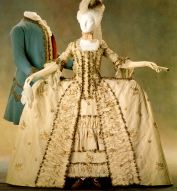 18th c. Men and the Ballet
18th c. Men and the Ballet
The true star of early courtly ballets was the aristocratic male. In fact, a man’s form, strength and agility in dance were often equated with his prowess in militaristic endeavors. “During wartime, nobles were in the service of the king’s army, but in times of peace they were in the service of his ballet” (Lee 1999, p. 68). For this reason courtly dances were seen predominantly as opportunities to display one’s athleticism and as such, the danseur performed techniques that exploited and extended his body’s natural range of motion (Fermor 1993). However, the weighty dresses of women kept their movements small and mincing, relegating them to the wings, while men, donning form-fitting stockings (the better to display their legs), could move relatively freely (Beaumont 1946). This may reveal another reason for the relatively insignificant role women played in the eighteenth-century ballets.